Here we will post our analysis of the answers to the questions. We will work in pairs or small groups, and analyse/comment two questions at a time. Here is the data to be commented:
data_QOL_AT_REU_2021-01-04.xlsx
Analysis by the students from Austria
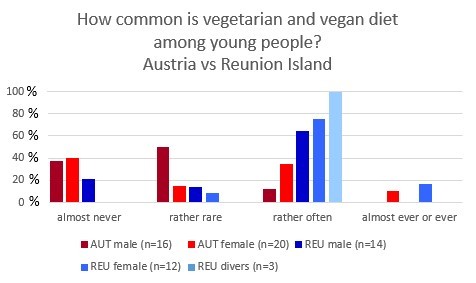
This diagram shows how often students eat vegetarian or vegan meals at their school. 68 people took part in the survey and three out of those are not counted.
It can be read from the diagram that on average the students in La Reunion eat vegetarian or vegan food in school more often than students in Austria. Furthermore, one can see that more girls consume vegetarian or vegan food.
In addition, we did not expect that so few would eat almost ever or ever vegetarian or vegan. What was to be expected, however, is that it's only girls who almost ever or ever eat vegetarian / vegan. Studies show that on average more women relinquish meat or animal products.
According to a survey from 2019 8 percent of the population in Austria already have a vegetarian or vegan diet. Another 17 percent eat vegan or vegetarian at least temporarily. (Schultz, 2020)
Consequences of high meat consumption
Animal products are the food with the greatest impact on the climate, as the deforestation of rainforests for feed cultivation areas results in the emissions of the animals themselves and all associated transports produce an enormous amount of greenhouse gas emissions. (Global 2000)
Furthermore, a high consumption of meat can pose a risk to a person's health. According to the researchers in the journal “Archives of Internal Medicine” the life expectancy of people who consume a lot of meat is reduced and one has an increased risk of heart attack, stroke, diabetes and various cancers. (Bartens, 2012) (Laura and Lea)
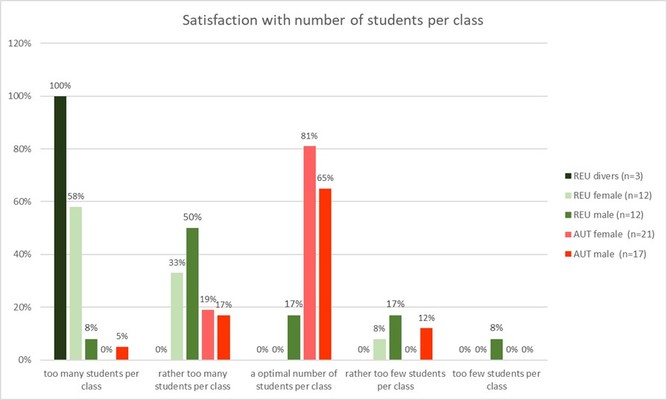
This diagram shows the satisfaction of the pupils related to the number of students in Austria and Reunion Island. Two out of the 69 answers are not being counted. Something really interesting that immediately recognizable is the big difference between Reunion and Austria in general. While over 90% of the young girls from Reunion mention, that there either “too many students per class” or “rather too many students per class”, are the students here in Austria pretty happy with their class situation, as over three quarters in total mention. One fact that could probably substantiate this evaluation, is the fact, that there are in Austria on average only around 20- 25 pupils in one class, usually even less, as orf.at or schulautonomie.at prove, and in Reunion Island often over 32 students! Something, that is not really surprisingly to us, is the fact that there aren’t any big differences between girls and boys from the respective country and there is not one “runaway” at all, boys and girls see feel nearly the some about their class situation (Katharina and Vera).
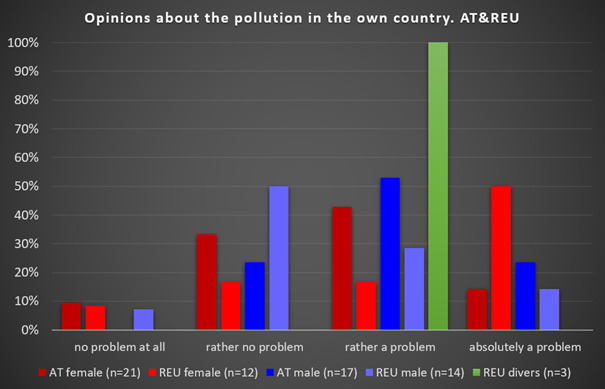
Most students in La Réunion and Austria think that pollution is a problem in their country.
There are deviations to those who think it is a big problem and to those, whose opinion is, that pollution is a small thing.
Only very few people, mostly girls, believe that pollution is not a problem at all.
It was pretty predictable that most students think that pollution is a problem, because you hear about it in the news and learn about it in school.
The results mean that rather many students look after the environment. A proof for that are the “Fridays for Future” protests where mostly students were involved.
Air pollution is one of the largest problems for the health and the environment and attributed to 5 million deaths each year. The sources for this information are the journalists Hannah Ritchie and Max Roser, who wrote an article about air pollution and published it on the website “ouworldindata.org” (Samuel and Madeline)
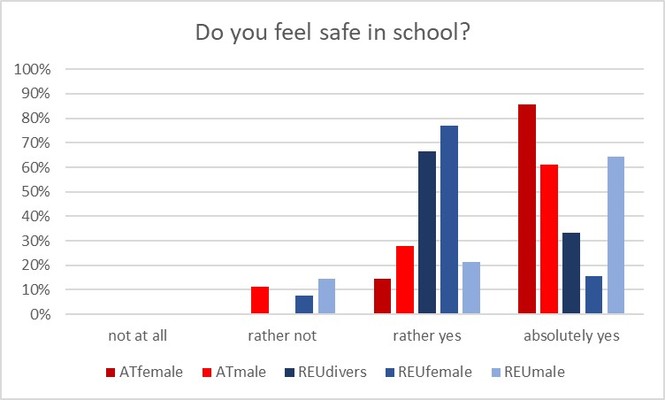
My expectations have been met concerning the point that young people in Austria feel quite safe at school. The numbers of la Réunion surprised me, because la Réunion is actually more known as a dream island than an island with a high level of crime. That is why I had completely different expectations. It is understandable that girls do not feel completely safe at school due to the higher crime rate.
From a social point of view, this means that girls do not feel 100% comfortable at school in la Réunion. The best way to improve this situation is to spend money on this issue. On the other hand, boys are relatively unconcerned. In Austria, the majority of boys and girls feel safe at school.
Bernard Rémy (2020) writes in his scientific paper on "La délinquance à La Réunion: entre mythe et réalité” that the proportion of crimes against morality, including offences related to prostitution, pornography and homosexuality is significantly higher than in Paris. Furthermore, Rémy (2020) indicates that the proportion of crimes, either assassinations or murders, contained in premeditated attacks against people or violations of morality, is much higher in Réunion than in Paris. According to the newspaper "Le Figaro", Réunion is the tenth most dangerous department in France (France has 101 departments) with 10 acts of violence per 1000 inhabitants. In Austria, this figure is only around 8 acts of violence per 100 000 inhabitants (source: Austrian Federal Criminal Police Office). Until recently, Réunion was the poorest overseas department of France, and crime found accordingly a good breeding ground.
(Raffael and Marwin)
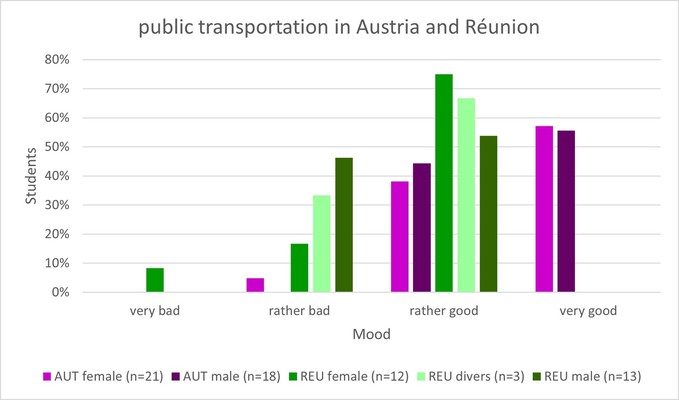
This diagram shows how the students from Austria and Réunion rate the public transport system in their country. The 97% of students from Austria voted that the quality of their public transport system ranges from good to very good. While 96% of the students in Réunion think they are more in the rather bad to rather good spectrum. As we already expected the public transport is better perceived in Austria than in Réunion.
A good and reliable public transport system is very important for a country. Its economy can flourish since people depend on it. They can use it to go to work or to visit school and for leisure time.
[Thomas Fessl, 2018]1 Therefore it has also a social impact on a country since it makes people without cars more flexible. Additionally, it has an environmentally friendly effect since it reduces the air pollution from vehicles. (Emily, Rebekka)
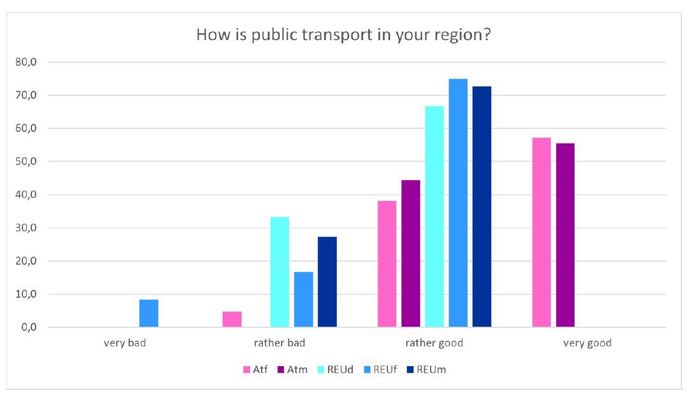
The diagram above shows that public transport is well developed in Austria as well as in La Réunion. You can see that most students feel this way, but only a few are of the opinion that there is not enough public transport. Its very obvious that students from Austria are very satisfied with public transport in their country, while students from La Réunion are less satisfied. Fortunately, only a small number of the female students from La Réunion voted that public transport is very bad in their region.
After some research it becomes clear that public transport in Austria is very reliable and punctual. In Austria public transport connections allows one to reach every corner of the country. On the other hand in La Réunion it became evident that there are not enough connections and that they are only available in very large intervals of time. In addition, it turns out that there are no trains in La Réunion.(Isabelle, Leonie)